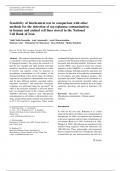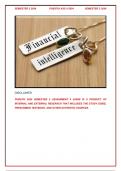ORIGINAL RESEARCH
Sensitivity of biochemical test in comparison with other
methods for the detection of mycoplasma contamination
in human and animal cell lines stored in the National
Cell Bank of Iran
Vahid Molla Kazemiha •Amir Amanzadeh •Arash Memarnejadian •
Shahram Azari •Mohammad Ali Shokrgozar •Reza Mahdian •Shahin Bonakdar
Received: 20 July 2013 / Accepted: 28 August 2013 / Published online: 4 February 2014
/C211Springer Science+Business Media Dordrecht 2014
Abstract Mycoplasma contamination in cell culture
is considered as serious problem in the manufacturing
of biological products. Our goal in this research is to
find the best standard and rapid method with high
sensitivity, specificity, accuracy and predictive values
of positive and negative results for detection of
mycoplasma contamination in cell cultures of the
National Cell Bank of Iran. In this study, 40 cell lines
suspected to mycoplasma contamination were evalu-
ated by three different methods: microbial culture,
enzymatic mycoalert/C210and molecular. Enzymatic
evaluation was performed using the mycoalert/C210kit
while in the molecular technique, a universal primer
pair was designed based on the common and fixed
16SrRNA ribosomal sequences used. Mycoplasma
contaminations in cell cultures with molecular, enzy-
matic and microbial culture methods were determined
as 57.5, 52.5 and 40 %, respectively. These resultsconfirmed the higher rate of sensitivity, specificity and
accuracy for the molecular method in comparison with
enzymatic and microbial methods. Polymerase chain
reaction (PCR) assay based on fixed and common
sequences in the 16SrRNA, is a useful valuable and
reliable technique with high sensitivity, specificity and
accuracy for detection of mycoplasma contamination
in cell cultures and other biological products. The
enzymatic mycoalert/C210method can be considered as a
substitution for conventional microbial culture and
DNA staining fluorochrome methods due to its higher
sensitivity, specificity and speed of detection ( \20
min).
Keywords Mycoalert/C210/C1Cell culture /C1
Mycoplasma contamination /C1Human-animal
cell lines
Introduction
In 1956 for the first time, Robinson et al. ( 1956 )
observed that their cell cultures were contaminated by
mycoplasma. In 1960s, mycoplasma were introduced
as the most important and prevalent contaminatons in
cell cultures (Razin et al. 1998 ; Yavlovich et al. 2006 ;
Zhang et al. 2006 ). Mycoplasma are considered as the
smallest living organism within the submicron size
(200–800 nm). These polymorphic microorganisms
that are categorized in the class of mollicutes and order
of tenericutes are also characterized by the lack of aV. Molla Kazemiha /C1A. Amanzadeh /C1
S. Azari /C1M. A. Shokrgozar (&)/C1S. Bonakdar
National Cell Bank of Iran, Pasteur Institute of Iran,
Tehran, Iran
e-mail: mashokrgozar@pasteur.ac.ir
A. Memarnejadian
Department of Hepatitis and AIDS, Pasteur Institute of
Iran, Tehran, Iran
R. Mahdian (&)
Molecular Medicine Group, Department of
Biotechnology, Pasteur Institute of Iran, Tehran, Iran
e-mail: rezamahdian@yahoo.com
123Cytotechnology (2014) 66:861–873
DOI 10.1007/s10616-013-9640-9 cell wall, self multiplication within 1–9 h and geno-
mic size of 600–2,200 kilobases. Of around 200
species available in the class of mollicutes, some are
saprophytes with a commensal life in human, animals,
insects, plants and some others like Mycoplasma
pneumonia ,Mycoplasma genitalium ,Mycoplasma
hominis andUreaplasma urealyticum are pathogenic
species infecting genitourinary and nasopharyngeal
tracts (Harasawa et al. 2005 ; Waites et al. 2005 ).
A mycoplasma contamination may affect physiol-
ogy, growth, morphology as well as biochemical,
immunological and genetic characteristics of the
cultured cells. Therefore, interpretation of the biolog-
ical tests on these cells will be affected by incorrect
results. In order to increase the quality and safety of
the biological products prepared in animal cell
cultures, US Food and Drug Administration (FDA)
strongly recommends the application of mycoplasma-
free cells approved by proper detection tests (Cheng
et al. 2007 ; Dabrazhynetskaya et al. 2011 ; Huang et al.
2008 ; Uphoff and Drexler 2011 ). It has been reported
(in different studies) that between 5 and 87 % of the
cell lines have been contaminated by mycoplasmas.
From more than 200 mycoplasma species, 20 have
been isolated from cell cultures (Uphoff and Drexler
2013 ). Eight species including M. arginini ,M.
fermentans ,M. hominis ,M. orale ,M. hyorhinis ,M.
salivarium ,M. pirum and A. laidlawii are responsible
for more than 95 % of cell culture contaminations
(Harlin and Gajewski 2008 ; Markoullis et al. 2009 ;
Timenetsky et al. 2006 ). The main sources of myco-
plasma contamination in cell cultures are laboratory
staff, serum, culture media, materials, reagents,
instruments and previously contaminated cells. Mean-
while, mollicutes may be present in cell cultures
without any superficial detectable effects like turbidity
or pH changes (Zhao et al. 2008 ; Nikfarjam and
Farzaneh 2012 ; McGarrity et al. 1985 ). Several
techniques have been developed for mycoplasma
detection in cell cultures including direct microbial
culture or indirect non culture methods. These tech-
niques have differences in accuracy, reliability, sen-
sitivity, specificity, precision and also cost-efficiency
(Kong et al. 2007 ; Peredeltchouk et al. 2011 ). Culture-
based methods are considered as time consuming
(days to several weeks) and low sensitive methods
with relatively high false negative results, which needs
expert interpretation. In addition, some of myco-
plasma species such as M. hyorhinis are hardly grownin culture and not detectable with culture-based
methods. Nonetheless, microbial culture is still con-
sidered as the gold standard for mycolplasma detec-
tion. Non-culture-based methods include screening of
Adenosine phosphorylase (Adop), cell markers, bio-
chemical and immunological techniques, DNA fluo-
rochrome staining, electron microscopy, DNA-RNA
hybridization, one-step PCR, nested PCR, PCR-
ELISA, genus and species specific PCR with universal
and multiplex primers and real time PCR (Hopert et al.
1993 ; Lawrence et al. 2010 ; Sto¨rmer et al. 2009 ; Zhi
et al. 2010 ). These methods are generally more cost-
effective and easier to perform, however, they have
their own disadvantages from the view of sensitivity,
specificity and accuracy. In this research, microbial
culture (as a gold standard), enzymatic (mycoalert/C210
kit) and PCR methods were utilized for the detection
of mycoplasma contamination in the cell collections of
the National Cell Bank of Iran. The sensitivity,
specificity, accuracy and operation time (speed) of
these methods were compared in order to identify the
optimal method of choice.
Materials and methods
Cell cultures
Different animal and human cell lines available in the
National Cell Bank of Iran were randomly selected and
evaluated by microbial culture, enzymatic (mycoalert/C210,
Lonza, Basel, Switzerland) and molecular detection
methods (Table 1). These cell lines were incubated at
37/C176C in 88 % humidified and 5 % CO 2atmosphere.
The culture medium for each cell line was prepared
according to the recommended instructions and supple-
mented by 10–20 % fetal bovine serum (FBS) and
growth factors. The following reagents were used: Fetal
Bovine Serum (FBS, Gibco/C210-Invitrogen, Cat No:
10270-106), Roswell Park Memorial Institute medium
(RPMI, Gibco/C210, Cat No: 51800-035), Dulbecco’s
Modified Eagle Medium High Glucose (DMEM, Gib-
co/C210, Cat No: 52100-021), F12 nutrient mixture
(Hams’F12, Gibco/C210-Invitrogen, Cat No: 21700-075),
Non Essential Amino Acid (NEAA, Gibco/C210MEM, Cat
No: 11140076), Penicillin/Streptomycin (Gibco/C210,C a t
No: 15140-130), Horse serum (Gibco/C210, Cat No:
16050-130 (origin: New Zealand)), Trypsin-EDTA
(Gibco/C210, Cat No: 25300-054), 100 mM Sodium862 Cytotechnology (2014) 66:861–873
123






